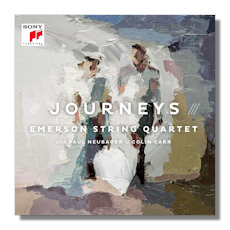
The Internet's Premier Classical Music Source
Related Links
-
Schoenberg Reviews
Tchaikovsky Reviews - Latest Reviews
- More Reviews
-
By Composer
-
Collections
DVD & Blu-ray
Books
Concert Reviews
Articles/Interviews
Software
Audio
Search Amazon
Recommended Links
Site News
 CD Review
CD Review
Journeys

- Piotr Ilyitch Tchaikovsky: Souvenir of Florence
- Arnold Schoenberg: Verklärte Nacht
Paul Neubauer, viola
Colin Carr, cello
Emerson String Quartet
Sony 8725-47060-2 61:42
Not that I have heard them all, but this is the most persuasive account of Souvenir of Florence I have ever heard. I will say that the first recorded version of this late Tchaikovsky work was so unimpressive, not to say repellent, that I could not get it out of the house fast enough. A friend once declared that there were such things as "evil performances," which were bad because they made you think badly of a work. This is definitely not one of those.
The Emerson Quartet, supplemented by a second viola and a second cello, leaves nothing to be desired in this account. The opening movement, Allegro con spirito, requires energetic forward motion, and it gets it here. The beautiful Adagio cantabile e con moto is played at exactly the right tempo to be thoroughly pleasurable. The third and fourth movements are also played at well-chosen tempos, which make the difference between satisfaction and irritation.
Souvenir of Florence is one of Tchaikovsky's last works, composed in the summer of 1890. It does not make any departures from the harmonic or melodic approach which has made his work in general highly popular. As a piece of chamber music, it uses the same forces as the two sextets by Brahms.
Schoenberg's Verklärte Nacht (Transfigured Night), Op. 4, composed during the same decade as the Tchaikovsky, in 1899, was originally composed with the same instrumentation as Souvenir of Florence, as we hear it here, but could not sound more different. This was Schoenberg's first notable work. It came long before the composer's twelve-tone period, and even before his more chromatic works; it is in fact a late Romantic work, perhaps pre-figuring his Expressionistic works, but it is intense. In 1917 Schoenberg made a string orchestra version of the work, and revised it in 1943, and that version is probably better known than the original. Certainly I was familiar with the orchestral version many years before hearing the original version.
It is good to hear this work as Schoenberg first conceived it. The string orchestra version may have a greater sensuous impact, and the changing dynamics may have a greater gut impact, but with the sextet, especially when performed and recorded as well as it is here, the instrumental parts are heard more clearly. Anyone seriously interested in this work will want good examples of both versions.
Highly recommended.
Copyright © 2013, R. James Tobin





















